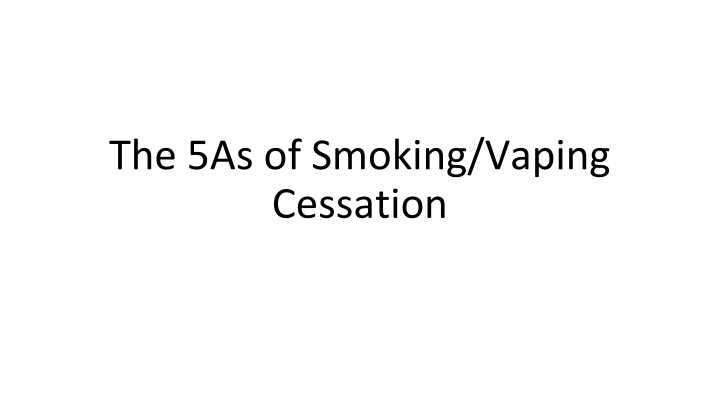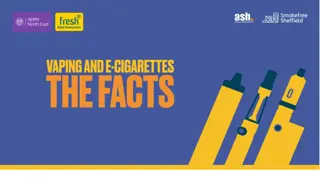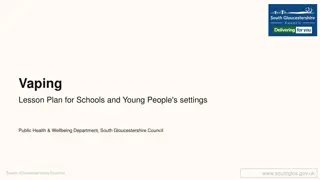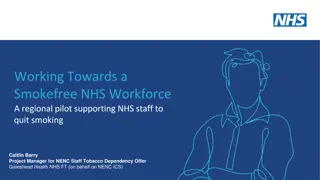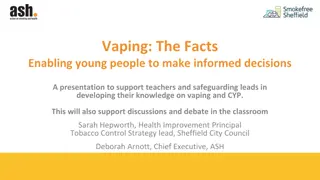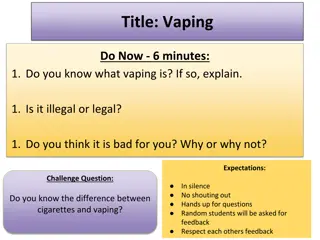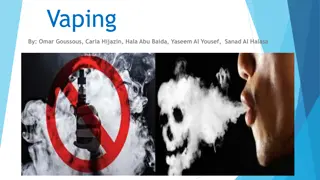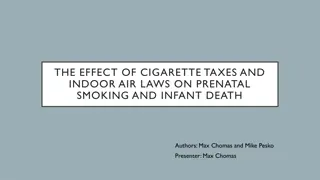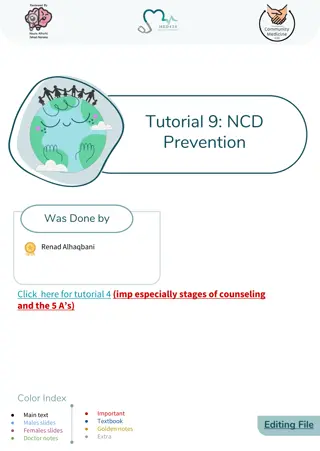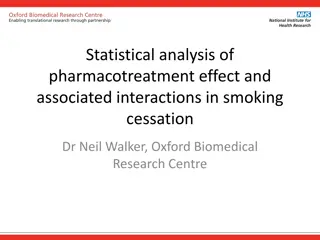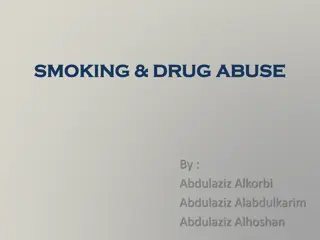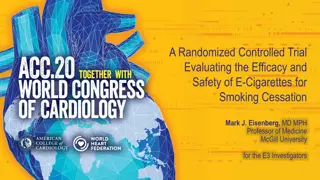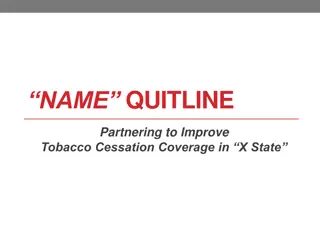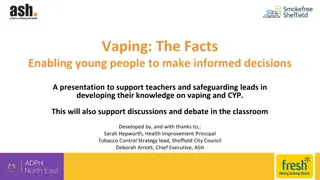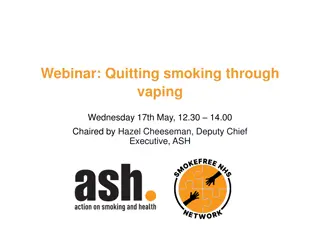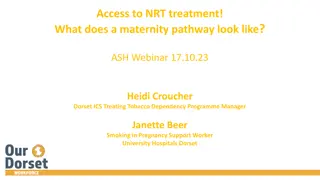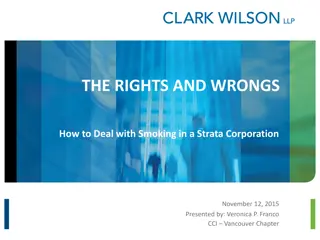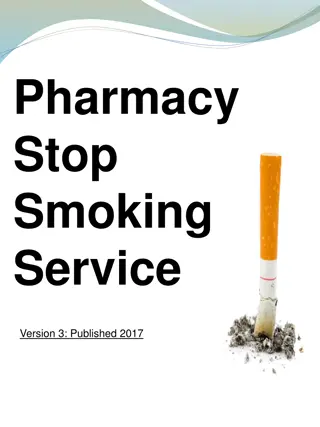Comprehensive Guide to Smoking/Vaping Cessation for Teens
Learn about the 5 As model of smoking/vaping cessation - Ask, Advise, Assess, Assist, Arrange. Discover the importance of screening for vaping use, providing clear recommendations to quit, assessing addiction levels, and developing a quitting plan with online resources for teens. Take steps to support teens in their journey to quit smoking/vaping.
Download Presentation

Please find below an Image/Link to download the presentation.
The content on the website is provided AS IS for your information and personal use only. It may not be sold, licensed, or shared on other websites without obtaining consent from the author.If you encounter any issues during the download, it is possible that the publisher has removed the file from their server.
You are allowed to download the files provided on this website for personal or commercial use, subject to the condition that they are used lawfully. All files are the property of their respective owners.
The content on the website is provided AS IS for your information and personal use only. It may not be sold, licensed, or shared on other websites without obtaining consent from the author.
E N D
Presentation Transcript
The 5As of Smoking/Vaping Cessation
5 As Model of Smoking/Vaping Cessation Ask Advise Assess Assist Arrange
Ask It s important to screen your patients for vaping use. Adolescents are usually honest on paper screening forms. Some templates specific to vaping/e-cigarette use include the Hooked on Nicotine Checklist (LINK) or E-cigarette Dependence Scale (LINK) both of which are validated for this purpose Other ways of asking teens can be direct or indirect ( Do you vape? Smoke? ) ( Have any of your friends vaped? Have you ever been offered a vape? Did you try it? )
Advise Make a clear, personal recommendation to quit. This is a good time to pull out motivational interviewing skills and see how you can offer information to help a teen develop understanding about their addiction.
Assess Assess their degree of addiction. This can often be surprising to the teen themselves! To calculate nicotine consumption, ask the teen 1) what vape they use, 2) what nicotine concentration they use (this is a percentage), and 3) how long it takes them to go through a pod/cartridge Multiply nicotine percentage by 10 (e.g. 3% nicotine x 10 = 30 mg/mL) Identify how much liquid is contained in the vape (e.g. JUUL uses 0.7 ml pod; Vuse uses 2 ml cartridge) Multiply nicotine concentration by quantity of liquid to get nicotine contained in one pod/cartridge (e.g. 30 mg/mL x 2 mL = 60 mg) Assess how much nicotine they are getting on a daily basis and convert to packs per day (1 ppd = approx. 20 mg). For example, if a teen goes through a Vuse vape in 3 days, they are effectively getting 1 pack/day of nicotine or 20 mg/day
Assist Develop a plan to quit together with the teen. Several online sites help make this easy. For Maine, My Life My Quit (LINK) is the teen site from the Maine QuitLink (LINK) and VapeFreeMaine (LINK) for 13- 17 year-olds. This site is easy to use and offers excellent resources for teens and parents, including text-based services, online chat, or direct phone line to call. Smokefree Teen from the National Cancer Institute offers an excellent Build My Vaping Quit Plan (LINK) that is easy to use. This is Quitting (LINK) is another site for 13-24 year-olds from the Truth Initiative and offers text-base structured quit support. In all cases, it is important to loop the patient in with behavioral support. Ideally this would be a professional trained in CBT or drug addiction. However, in today s environment that is not always realistic. At the very least, frequently having the teen back to talk about their struggles with you in the office may be an option if immediate behavioral supports cannot be attained.
Assist (continued) In some cases, pharmacotherapy is an option to help with nicotine addiction. This can be broken down into nicotine-based therapies (NRT) and non- nicotine based therapies. Nicotine based therapy includes gum, patch, lozenge, nasal spray and inhalers. None of these are FDA-approved for patients under 18 years of age and must be prescribed. The AAP has an excellent document that outlines how to prescribe the gum, patch and lozenge to teens motivated to use them (LINK). Non-nicotine therapy includes buproprion (Wellbutrin) and varenicline (Chantix). Buproprion is an antidepressant used for smoking cessation and can be prescribed to teens 15+ yrs. However, it should not be used in anyone with a history of seizures, eating disorders, or complex alcohol use. It also has significant side effects including agitation, insomnia, weight loss, headache/migraine, nausea/vomiting, constipation, and xerostomia among others. Buproprion should be started prior to quitting to achieve a steady state and quitting should happen around the 3rdweek of therapy. Varenicline is a partial neuronal nicotinic receptor agonist and helps reduce nicotine cravings. This medication is not recommended for patients 16 yrs or younger. Studies have shown that it can be helpful with initial cessation but is no different from placebo for prolonged quitting. Side effects include abnormal dreams, nightmares, nausea, depressed mood and irritability.
Arrange Check in every 1-2 weeks to provide support. This process is well suited to telemedicine!
